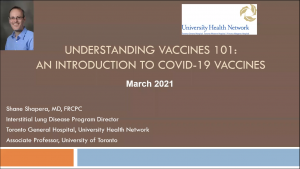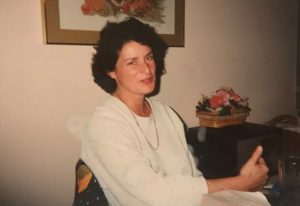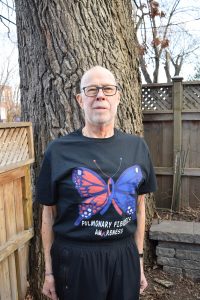Anti-fibrotic drugs and the COVID-19 vaccines and a new vaccine webinar

The Canadian Pulmonary Fibrosis Foundation (CPFF) has reached out to the appropriate pharmaceutical companies and the experts on our Medical Advisory Board to address your concerns about whether you can have a COVID-19 vaccine while taking anti-fibrotic medications such as nintedinab (Ofev) or pirfenidone (Esbriet).
To date, no studies have been conducted and so far no data is available on the combined use of COVID-19 vaccines and the anti-fibrotic drugs used to treat pulmonary fibrosis. However, there is no biological rationale to suggest that mixing anti-fibrotic drugs with COVID-19 vaccines would lead to any adverse effects. There is currently no recommendation to change the clinical use of nintedanib or pirfenidone in people with interstitial lung disease receiving a COVID-19 vaccine.
“If you have pulmonary fibrosis, I encourage you to receive any COVID-19 vaccine, as soon as it is offered to you,” says Dr. Shane Shapera, Director of the Interstitial Lung Diseases Program at the Toronto General Hospital, UHN and a member of CPFF’s Medical Advisory Board. “The risk of serious illness or death from COVID-19 for people with ILD far outweighs any small risks that may be associated with the vaccines. And, there is no evidence of adverse interaction between anti-fibrotic medications used to treat ILDs and the vaccines.”
Dr. Shapera has created a presentation, now available on the COVID-19 section of our website, which offers an overview of the COVID-19 vaccines and how they work, as well as considerations for those living with ILD. Please note that the information in this webinar about the vaccine roll-out and distribution applies only to Ontario. Vaccine distribution, priority access and timelines will differ in other provinces and territories.
For personal information about whether you should receive a COVID-19 vaccine, consult your health care provider or ILD specialist for an individual risk/benefit assessment based on your current medical condition and medical history as well as COVID-19 vaccine label information on contraindications, special warnings and precautions and drug interactions.

Thank you to everyone who responded to our February survey about our Hope Breathes Here campaign for Pulmonary Fibrosis Awareness Month 2020. Your feedback and ideas will be very helpful in planning Awareness Month activities for September 2021.
Here is a brief summary of the results:
Almost all of the respondents would recommend Hope Breathes Here to a friend, family member or healthcare professional.
Here are the activities respondents indicated they would like to see again in September 2021, in ranked order:
- Live streaming of education sessions
- Recorded on-demand education sessions
- Tribute to, or shared stories of a loved one
- Government official proclamations and lighting of landmarks
- Virtual bubbles
- Wrap-up & Applause
- CPFF Clarke Walk
Respondents offered suggestions for education sessions in 2021, including: COVID-19 vaccines, palliative care, do not resuscitate orders, end of life planning, life after transplant, depression and COVID-19, Financial and Will preparation and navigating oxygen therapy: how to qualify and pay for it.
Respondents also had a few suggestions about the campaign overall, including: A single registration for all activities; having recorded education sessions available sooner; enabling people to walk in support of their own loved one in the same format at the Clarke Walk; offering other fundraising activities; and conducting a government advocacy campaign in September on the needs of the PF Community.
Finally, if you are interested in a volunteer opportunity, CPFF is looking for people to approach local officials to help secure government proclamations and landmark lighting for Pulmonary Fibrosis Awareness Month in September 2021. Please contact Executive Director Sharon Lee at [email protected].
Creating a special tribute webpage

When a loved one passes away from pulmonary fibrosis, often the family offers the option for friends and family to make a donation to the Canadian Pulmonary Fibrosis Foundation (CPFF), in lieu of sending flowers, as part of a newspaper obituary. For family members with a broad social media network, this doesn’t always seem like enough, or the best way to reach out, especially now with in-person memorials restricted by the pandemic.
For a more personal remembrance, you can create a tribute webpage with help from CPFF. Send us your written tribute (no more than 500 words in a WORD document), with up to three images (as jpgs), and we’ll create a tribute webpage for your loved one and send you a link that you can send to your friends and family to read about and remember your loved one. They can also make a donation to CPFF directly from the tribute webpage.
For an example, visit the tribute page for Marjorie (Bunty) Zantolas, submitted recently by her daughter Natalie Marino, who gave us permission to share this information with our readers. It’s a warm and lovely memorial to her beloved mother.
If you’d like to set up a tribute page, please send your written tribute and photo(s) by email to Sharon Lee at [email protected]. If you’d like more information about this option, please contact Sharon.
John Dennis is happy to breathe again

“I can breathe now and it doesn’t hurt,” declares John Dennis just 19 days after his single-lung transplant at Toronto General Hospital (TGH) in early March. “I’m so happy. I wake up each morning thankful for another wonderful day.”
At 76 years of age, John is in the top five percent of people receiving a lung transplant, in terms of age. His surgery, age, and rapid recovery so far, meant he was featured at Grand Rounds, when his case was discussed by the hospital’s physicians.
His surgery lasted just 5 hours and 15 minutes. When John’s son Frank got the call from the doctor so early, he was expecting the worst, since the call came much sooner than the six to eight hours he was told the surgery would take. Surgeon Dr. Laura Donahoe declared that John was in excellent shape and she did not need to put him on heart-lung bypass during the surgery.
A week after surgery, John went to Toronto Rehab and four days later was discharged. His oxygen level has now settled at about 99 per cent. The only time it was that high before the transplant was when he was resting in bed with eight litres of oxygen.
John is still staying in Toronto with his son Frank, daughter-in-law Sarah and 10-year-old granddaughter Margaret and expects to return to his home in Halifax in June. He currently goes to TGH regularly for tests and rehabilitation therapy. All indicators are positive to date. On March 30, he walked 2.6 kilometres.
It’s been a long haul to this point with some trauma along the way for John and his family. His wife of 44 years, Penny, passed away on June 11, 2020. She had dementia and diabetes and had moved into a care home in Halifax just before the pandemic hit. At that time, John had also moved into a smaller apartment in the same care home complex. It was difficult to visit her once COVID-19 restrictions were in place.
John’s daughter Stephanie Walker and her husband Jes Walker live in England and were unable to travel when this tragedy struck. “She has been calling me daily since I was diagnosed and since I’ve been in Toronto,” says John. “And she told me she finally slept through the night for the first time in years when she learned I had survived the surgery.”
John had to move to Toronto last September in preparation for the transplant and by early October was on the transplant list. Frank, Sarah and Margaret have been loving and competent care givers, during his stay in Toronto. “Before we even left the parking lot at the Toronto airport, my son told me the two rules I needed to observe while in their home: One, I was grounded, and two, my only responsibility was to take care of myself so that I was ready for surgery.”
One of the hardest things was the wait for the lung, says John. With COVID-19, there were just not as many organs available and the hospitals were cutting back on surgeries. There was a false alarm in February. “I had one very bad day, when I got in touch with the program’s psychiatric nurse,” he says. “But, by the time she checked up on me the following day, I was OK.”
John’s also credits his faith and his church community with helping him remain sane and at peace. John actually called his minister the day after his surgery. “He was shocked to hear from me,” says John. “I asked him to thank everyone and let them know I was OK during the Sunday services.” When John watched the service virtually, the congregation stood and clapped when they heard the good news.
When John retired in 2008 and returned to his hometown of Halifax, he seemed to get sick each spring. In 2016 he attended his younger brother’s funeral and his sister-in-law told him his brother had had pulmonary fibrosis, but had told no one. John then revisited his symptoms and asked his family doctor to refer him to a respirologist. He had the clubbed fingers and the Velcro sounds in his lower lungs, typical of PF. He immediately went on nintedinab (Ofev).
John also founded the CPFF Halifax Support Group and its members have been a source of encouragement throughout his PF journey. “They have been just great, staying in touch. They are very pleased for me,” John says.
John has some advice to pass along to others living with PF and/or considering a lung transplant. “Learn to advocate for yourself and insist on being involved in decisions about your care,” says John. “And if you want a lung transplant, understand that you need to work for it if you want to ensure you have the best odds for a successful outcome. Exercise and get your BMI down to 27 or lower.”
John went from 240 pounds down to 175 and reduced his waist size from 42 to 35 inches. Early in his PF journey, he could walk up to 11 k. in a day, which gradually decreased to about 2.5 k. as he got sicker. “Some people have said to me, ‘We can’t all be you John,’ but I respond with ‘just be the best you can be. Give it your best effort.’”
John also urges people to get reliable information about their disease. Ask your doctor or specialist if you have questions. They know your history and the medical facts. “And, if you have doubts about what your doctor or respirologist is suggesting, speak up forcefully for yourself, and if you are still not comfortable, change doctors,” says John.
For now, John is focused on his continued recovery and making plans for the future. “Our family is looking forward to being able to gather with friends to remember Penny. And, I’m looking forward to travelling with my granddaughter Margaret in 2022 to England, France and Greece.
John is also planning on ways to continue to increase awareness and raise funds for CPFF. “I hope to be a spokesperson and spread the word about pulmonary fibrosis and the good work being done by CPFF, the medical community and researchers.”
You’re invited to a European virtual patient summit this month

The European Idiopathic Pulmonary Fibrosis & Related Disorders Federation, (EU-IPFF) will hold its first virtual European PF Patient Summit, April 23 to 25, 2021.
There will be presentations, panel discussions and roundtables and a special conference website, where all attendees can have an individual log-in and profile. Participants can choose which sessions to attend and which people to meet in the virtual conference room and registration is free to all. (NOTE: You’ll notice in the program that some of the live session times seem very early in the morning, this is because of the time differences between North America and Europe. The times are adjusted to your location when you register.)
According to Steve Jones, EU-IPFF President, the European PF Community is facing many of the same issues that we are in Canada:
“The Summit takes place at a time when the pulmonary fibrosis community faces the difficult challenge of raising awareness of the disease with the public and health care professionals. The pandemic has made governments everywhere think more about respiratory disease and consult respiratory clinicians and patient organisations for advice, expertise, and support. While this overdue recognition of lung health is welcome, we need to focus policy makers’ attention on the specific problems facing the 300,000 people across Europe living with pulmonary fibrosis. Our disease is not the same as asthma or COPD. Progressive pulmonary fibrosis has a worse prognosis than most common cancers, but we do not receive anything like the same level of support and care. While most cancer patients are diagnosed and start treatment in a few months, this is not the case for pulmonary fibrosis patients, who often must wait a year or more. Also, pulmonary fibrosis patients are especially at risk from COVID-19 and should be made a high priority for vaccination. There are many issues to discuss at the Summit!”
CPFF representatives will attend the EU-IPFF Patient Summit and plan to report on some of the highlights in future issues of this newsletter.
6 Ways to Help Others Manage Pandemic Stress
By Charlene Marshall
 Since the start of the pandemic, levels of stress, frustration, and confusion have risen to troubling levels. It seems that many of us also are experiencing more concern over new, rapidly spreading coronavirus variants.
Since the start of the pandemic, levels of stress, frustration, and confusion have risen to troubling levels. It seems that many of us also are experiencing more concern over new, rapidly spreading coronavirus variants.
When I first heard about the variants, I broke down and cried. I felt defeated and worried about our ability to collectively contain the spread of a more contagious version. All I could think about was how rapidly the original strain of the virus that causes COVID-19 spreads, in part because people don’t follow public health guidelines. How will we stop the spread of variants that are up to 70 per cent more contagious than the previous one?
Many columnists have written about the effect the pandemic has had on their lives. As rare disease patients, it makes sense that our current health crisis has caused fear and stress. In fact, a survey in the U.K. noted that the pandemic has had an “unrelenting” impact on those with pulmonary fibrosis. This likely is true for many other rare disease patients, too.
I have experienced myriad emotions, mostly negative, since the beginning of the pandemic. I’ve been fearful of the virus and frustrated with those who refuse to wear a mask, despite medical professionals pleading with them to do so. I have experienced intense sadness about the economic crisis it has caused, and grief due to the massive number of people who have died.
Despite all of these emotions, I thankfully acknowledge that my mental health isn’t yet suffering. I’ve identified coping strategies and rely heavily on those around me when I’m struggling. I regularly practice gratitude, which helps me settle negative emotions and thoughts.
However, I’m not naive: I know mental health issues don’t only affect rare disease patients, so it’s important to know how to help others who might not be coping well.
Following are six ways you can help others who may be facing pandemic-related stress:
- Send something handmade
Many of us enjoy quiet hobbies that don’t require a lot of energy. I enjoy making greeting cards as a way to occupy my mind while letting my body rest in a comfortable crafting chair. Sending someone a handmade card (or another item, such as a scarf or a painting) can really brighten their day.
- Cook extra to share
I love to cook and am slowly improving. But I always seem to end up with far too much food for just two people. Lately, I’ve enjoyed sharing what I make, particularly soup recipes, with neighbors and close friends. If you plan to make a homemade meal, make a little extra and help remove the stress from meal planning for someone who might be having a hard time.
- Randomly send a text or call someone
It takes minimal effort to send someone a text to let them know you’re thinking of them, but the benefits could be significant. Better yet, set aside some time to call them and actively listen to how they’re doing or what they might need in order to feel better.
- Go for a socially distanced walk
This might be difficult if you’re in the middle of winter like we are here in Canada. And keep in mind that wearing a mask outdoors is still recommended. If neither of these two factors deter you from getting some fresh air, enjoying a walk with a friend can relieve stress.
- Encourage healthy habits together
Healthy habits, such as being organized, sleeping, eating well, and taking time for yourself all help to reduce stress. But sometimes these habits aren’t achievable for someone who might be on their own. Why not work together to hold each other accountable?
- Use watch party apps
Being separated from others can be frustrating and lonely, but are you aware of watch party apps? Several platforms allow users to watch shows together. I haven’t tried this yet, but I look forward to doing so to safely spend time with friends.
Editor’s Note: This column was originally published on February 18, 2021 in Pulmonary Fibrosis News. Columnist Charlene Marshall is a 30-something Canadian, who was diagnosed with IPF in 2016.


